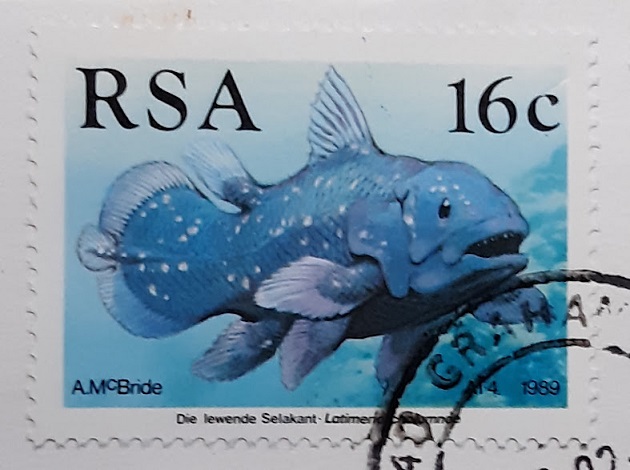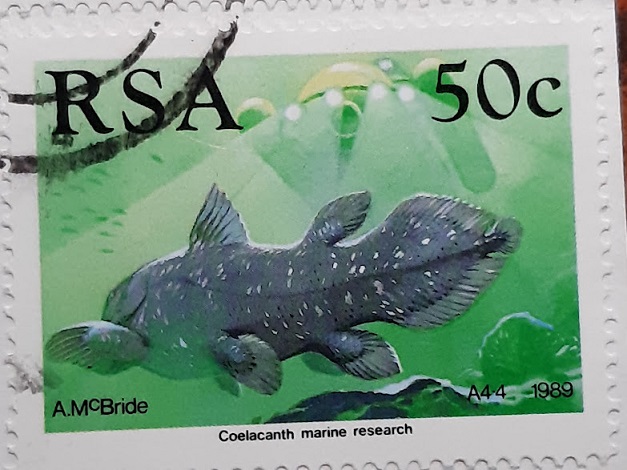It was on 20th February 1939 that the world found out that a Coelacanth had been caught off the Chalumna River mouth near East London. What made this headline news is that until then the Coelacanth was thought to have been extinct for nearly 70 million years. The fish had actually been brought ashore on 22nd December 1938 by the trawler Nerine, skippered by Captain H. Goosen. He was unable to identify this enormous fish measuring 1,5 m in length and weighing 57kg.
The Curatrix of the East London Museum, Dr Marjorie Courtenay-Latimer, had the fish treated and mounted by Mr R Center, a taxidermist, and sent sketches of it to Prof. J.L.B. Smith of Rhodes University in Grahamstown, who was able to identify it as a Coelacanth on 16th February 1939 and named it Latimeria chulumnae. The name is both a tribute to Dr Courtenay-Latimer and an acknowledgement of where the fish had been found. The scientific significance of the Coelacanth relates to it being the longest surviving species of a group of fishes known to have become extinct millions of years ago – the oldest known coelacanth fossils are over 410 million years old. It is the closest living relative of Rhipidistia, which emerged from water onto land and which may have given rise to higher forms of life.
After a fourteen-year search, Professor Smith and his wife Margaret found a second Coelacanth off the Comoro Islands. It is this specimen that is displayed at what used to be called the JLB Smith Institute of Ichthyology in Grahamstown – one of the first exhibits we visited on our arrival in this town. Since then a number of other Coelacanths have been caught off the Comores. Divers have since come across Coelacanths near the iSimangaliso Wetland Park off the KwaZulu-Natal coast. There are two species, the Indonesian and the West Indian Ocean coelacanth, of which the latter is found in South African waters.
16c stamp depicts a Coelacanth in its natural habitat.
30c stamp depicts Prof. J.L.B. Smith and Dr Marjorie Courtenay-Latimer with a Coelacanth.
40c stamp shows the JLB Smith Institute of Ichthyology which was established in Grahamstown in 1946 and which still plays a role in marine fish research. It is now known as The South African Institute for Aquatic Biodiversity.
50c stamp shows another view of the Coelacanth, along with a two-man research submarine, highlighting the need for marine research into conservation measures to protect this rare species.
The stamps were designed by A. McBride and the First Day Cover was issued in East London on 9th February 1989. It shows an outline of South Africa with the position of East London clearly marked and the trawler featured alongside. A painting of a Coelacanth features prominently below it.
The JLB Smith Institute of Ichthyology issued their own covers, as shown below.
The nickname, Old Four Legs, relates to the paired fins that gave rise to an initial thought that the Coelacanth may have ‘walked’ on these leg-like pectoral fins. Prof. Smith published a book, Old Four Legs about the discovery of this fish and subsequent research on it.









A really fascinating post – intriguing history and special philately
LikeLike
Thank you very much, Derrick.
LikeLiked by 1 person
Baie interessant. En hoe verlang ek nou na seëls. Ek het penvriende gemaak net om hulle bymekaar te kan maak.
LikeLike
Ek het ook penvriende gehad vir dieselfde rede 🙂 Dit is goed om weer van jou te hoor 🙂 🙂
LikeLiked by 1 person
Dankie, Anne, ek was rof besig, gaan stiller op die oomblik
LikeLiked by 1 person
Are you a philatelist as well as a photographer?
LikeLike
I used to collect stamps until a few years ago, so have an interesting collection which includes First Day Covers.
LikeLike
What an interesting story!
LikeLike
I am glad you find it so. It is also always interesting to learn of divers coming across live specimens in our waters.
LikeLiked by 1 person
I’m with Derrick and Going Batty in Wales. Fascinating story! However, I must add that those fins really don’t look like legs. 😉
LikeLike
If you look closely at the 16c stamp, you will note the four fins are underneath the body and could be taken for rudimentary legs – especially when studying a fish everyone had believed to be extinct for so long.
LikeLiked by 1 person
Interesting! I am glad that these days rare species are kept alive, only photographed and measured, then released back to the wild. There are numerous examples of early collectors (employed by museums and zoos) causing extinction of a species! The Guadalupe Caracara is one example.
LikeLike
You have chosen a fine example with which to illustrate your point 🙂
LikeLike
I remember how excited I was when I got the first postcard with an RSA stamp. That beautiful stamp from Africa was the reason I started collecting stamps.
LikeLike
If our postal service was more reliable, I could send you heaps more 🙂
LikeLiked by 1 person
I stopped collecting years ago 😦
LikeLiked by 1 person
I read a book on the coelacanth a few years ago, very interesting. The stamps are lovely.
LikeLike
I too think the stamps are well executed.
LikeLiked by 1 person
I remember reading about coelacanths as a child. Their story is fascinating. I do like the stamps, too.
LikeLike
What I find fascinating about it is that these fish were ‘missing’ for millions of years, found, held in awe, and are now seen fairly routinely.
LikeLike
Interesting post, Anne! I enjoyed the stamps as well.
LikeLike
I am pleased that you enjoyed it, Belinda.
LikeLiked by 1 person